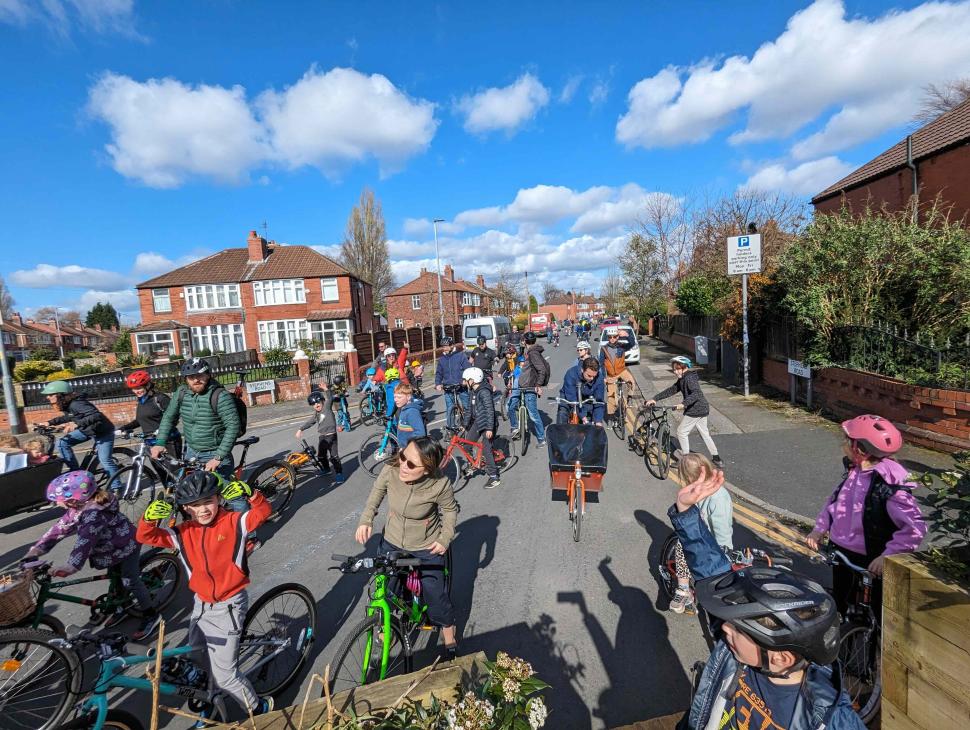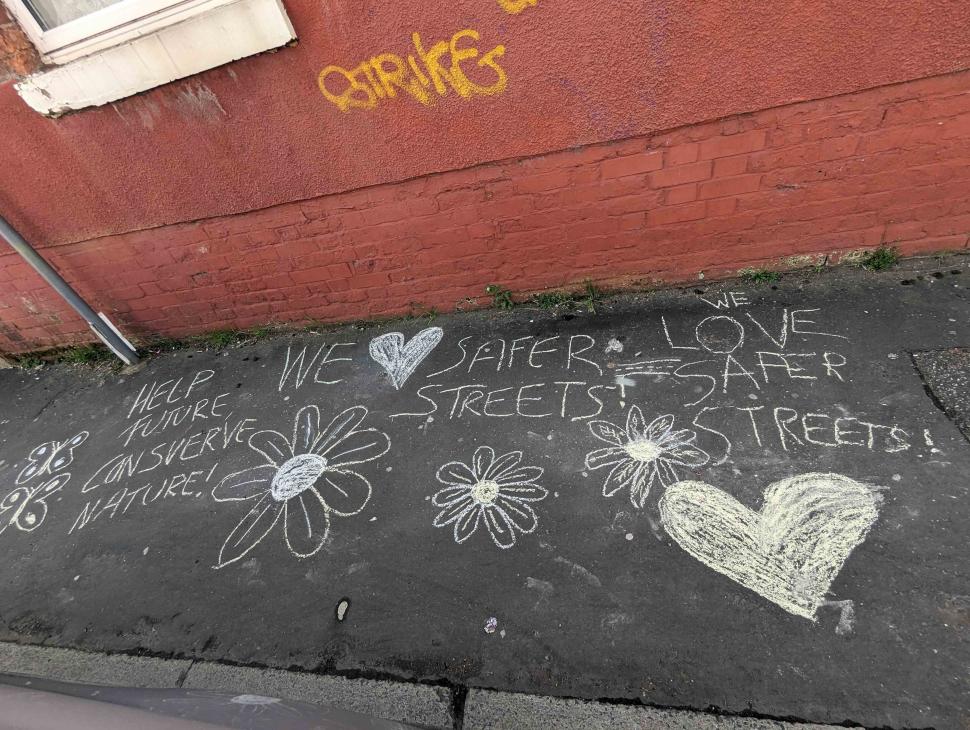- News
- Reviews
- Bikes
- Components
- Bar tape & grips
- Bottom brackets
- Brake & gear cables
- Brake & STI levers
- Brake pads & spares
- Brakes
- Cassettes & freewheels
- Chains
- Chainsets & chainrings
- Derailleurs - front
- Derailleurs - rear
- Forks
- Gear levers & shifters
- Groupsets
- Handlebars & extensions
- Headsets
- Hubs
- Inner tubes
- Pedals
- Quick releases & skewers
- Saddles
- Seatposts
- Stems
- Wheels
- Tyres
- Tubeless valves
- Accessories
- Accessories - misc
- Computer mounts
- Bags
- Bar ends
- Bike bags & cases
- Bottle cages
- Bottles
- Cameras
- Car racks
- Child seats
- Computers
- Glasses
- GPS units
- Helmets
- Lights - front
- Lights - rear
- Lights - sets
- Locks
- Mirrors
- Mudguards
- Racks
- Pumps & CO2 inflators
- Puncture kits
- Reflectives
- Smart watches
- Stands and racks
- Trailers
- Clothing
- Health, fitness and nutrition
- Tools and workshop
- Miscellaneous
- Buyers Guides
- Features
- Forum
- Recommends
- Podcast
 Parsonage Road LTN planters, Manchester (image supplied by Love Withington Streets)
Parsonage Road LTN planters, Manchester (image supplied by Love Withington Streets)“What are they going to do to keep my children safe?”: Active travel campaigners accuse council of ignoring report and listening to “bullies” after removal of Low Traffic Neighbourhood trial
Cyclists and active travel campaigners have criticised Manchester City Council for ignoring its own report showing the benefits of a Low Traffic Neighbourhood and instead base its decision on a survey which has been described as “non-representative” due to the flaws in accepting responses. However, the council has told road.cc that it’s working to install different traffic calming measures.
The ‘Safer Streets’ scheme was put in place on Parsonage Road, Withington as a trial running from August last year to February 2024. Following the end of the trial period, the impact of the measure was studied and residents were asked for their opinions about it, published in a report by the council on 27 March.
However, the council published its decision to remove the LTN on 8 April was published on 20 March — one full week before the report came out, leading to questions from local campaigners on whether the council even used the report to take the decision.
George Banfill from WalkRide Withington & Didsbury tells road.cc: “We are incredibly disappointed with this decision. It feels like the voice of the supportive majority has been ignored and the anti LTN group have bullied and harassed the councillors and council into removing the trial.
“The report is dated 27th March, yet the council published their decision on 20 March — was the report therefore not used in their decision making? Our local councillors made their decision weeks before the data was available — why?”
Safer Streets trial led to 55% drop in traffic
In August, Manchester City Council began a trial of nine temporary modal filters and the introduction of one-way streets in a residential area of Withington, centred around Parsonage Road. After six months, the assessment found “substantial reductions in traffic levels”, decreasing by 50 per cent in just one month and then a 55 per cent drop in traffic by February 2024.
There was also a reduction of average motor traffic speed between 16 and 23 per cent. In terms of boundary traffic, there was no noticeable change on the northern side. However, in the southwest area of the scheme, there was initially a 14 per cent increase in traffic, but it reduced to a six per cent increase by February, suggesting that there was a period of “bedding in” while the traffic adjusted to the new road layouts, according to the report.
But on the other hand, the online form used to collect feedback on the scheme painted a different picture. The reports states that 69 per cent of the respondents held a “negative” or “very negative” view of the trial, compared to the 29 per cent who had a “positive” or a “very positive” view.
Meanwhile, 64 per cent of the participants said the scheme would not make them more inclined to travel by active modes, as opposed to 27 per cent who said the scheme would initiate a behavioural change in them.
However, George claims that the results from the survey could have been influenced by the “loudest voices”. “The collection of information for B was flawed,” he says. “It was not representative polling — the survey didn’t account for multiple submissions by the same person, nor was there any way to exclude responses from people who weren’t residents of the area, so it may have been manipulated.”
He adds: “There was never any indication until the report that responses would be used to make the decision. If there had been, those more in favour may not have remained quiet.
“The council had said, ‘The success of the project will be measured through monitoring the changes in levels of motor traffic and numbers of people travelling actively as well as, perceptions and feedback from people who live, work and socialise in the area’. However the data appears to have largely disregarded.”
“My children have loved cycling and walking on these safer streets”
Siobhán O’Leary Donkin is a mother of two who lives on Alan Road in Withington, one of the roads which had a modal filter installed as part of the Parsonage Road scheme. She was involved in setting up the Love Withington Streets campaign on social media to try and celebrate safer streets for cyclists, walkers, and just families, in general, she told road.cc.
She points out that the state of the roads in Withington have been abysmal. Two persons — a 19-year-old girl crossing a road, and man in his 30s riding a scooter, have lost their lives due to drivers crashing into them over the last six years in the area.
In another instance, a motorist drove his car at 65mph in the 30mph area and crashed after a high-speed police chase, leaving his two passengers with serious head injuries and fractures.
“What I’d personally like people to understand is that this scheme was called for by the residents of Withington because the former situation was so dangerous,” she says.
“The scheme has stopped people speeding down two very long roads — Alan Road and Parsonage. Because traffic has been forced onto other roads, the overall speed has to come down, and this will save lives. With the larger straight wider roads left unblocked after the removal of the trial, we will return to these incredibly high speeds of 60-70 and there will be more fatalities. The planters that are remaining will not solve this as they aren’t in the right place.”
Siobhán adds: “My children have loved cycling and walking on these safer streets, we are heartbroken than with the planters going. we will feel less safe, less part of a community, less healthy — but ultimately more afraid.
“We’d call on the MCC to keep the trial for at least 12 more months. If they won’t do that, then what are they going to do to keep my children safe in getting to and from school? Will it take another serious accident before the council acts?”
It’s not just the Manchester City Council which has ignored a report presenting the benefits of LTN. Last month, the government sources claimed that Rishi Sunak’s “pro-motorist” government was responsible for trying to bury a report into the success of Low Traffic Neighbourhood (LTNs) schemes throughout England, which concluded that they are effective in reducing traffic and generally popular among residents was buried by Downing Street.
Similar events, however, have previously taken place in Manchester as well. Two years ago, cycling advocates were left disappointed when proposals for an active travel scheme in Wythenshawe were scrapped after locals raised concerns that the plans would “not make walking and cycling easier” in the area.
However, many campaigners and some residents felt that the council took the decision in a haste — the consultation was closed in just 15 days — to accommodate motorists’ concerns.
road.cc contacted the council for a statement regarding the Parsonage Safer Streets, and a spokesperson for Manchester City Council said: “Following a trial period where extensive feedback was gathered from a range of community voices in Withington the Council has made a decision not to make the changes put in place permanent. The feedback used to inform that decision included all information contained within the published scheme evaluation report.
“Work is now underway to explore options for an alternative scheme. Throughout this entire scheme the Council has wanted to make sure that local residents had a voice in how their community was shaped. This decision is a result of listening to that feedback.
“While we understand there are some people who will not be happy with this decision, it is important to note that the area will not be reverting to how it was before the trial. The Council is working to secure additional funding that would allow the installation of different traffic calming measures to address concerns that have been made by residents throughout the trial.
“Safety has always been at the heart of what the Council aimed to achieve with this scheme and we would like to reassure residents that efforts will continue make Withington’s streets cleaner, greener and safer.”
Adwitiya joined road.cc in 2023 as a news writer after completing his masters in journalism from Cardiff University. His dissertation focused on active travel, which soon threw him into the deep end of covering everything related to the two-wheeled tool, and now cycling is as big a part of his life as guitars and football. He has previously covered local and national politics for Voice Cymru, and also likes to write about science, tech and the environment, if he can find the time. Living right next to the Taff trail in the Welsh capital, you can find him trying to tackle the brutal climbs in the valleys.
Latest Comments
- aramaerospace 28 min 56 sec ago
Plastics are a world of their own - some are even more durable than many metals. We work with abrasion-resistant specialty plastics that offer...
- Geoff H 2 hours 8 min ago
I was really enjoying the article until I came to the price!
- OldRidgeback 3 hours 1 min ago
I have a very old MTB (guess what make) that I'll happily leave locked at the train station or shops or whatever. The fairly new Trek MTB or...
- TheBillder 4 hours 35 min ago
Dualling that stretch of the A7 will allow hard-pressed motorists to travel very slightly faster between the rock that is the Sherriffhall...
- BikingBud 4 hours 43 min ago
I refer to being an engineer only to emphasise my consideration of the logical approach that should be applied in the justice system, rather than...
- David9694 6 hours 13 min ago
Parking fail as car left teetering on top of stone wall Oh dear https://www.devonlive.com/news/local-news/parking-fail-car-left-teeterin...
- jaymack 7 hours 32 min ago
We must be related!
- The_Ewan 9 hours 2 min ago
But why worry if a few people do? It's just not a big deal....
- Tom_77 10 hours 6 min ago
Tempted to get him a sweary birthday cake like in The Thick Of It....
- Bigtwin 10 hours 34 min ago
Didn't happen did it? They came into my shop a couple of years back and said it was "on the way", but never heard anything more.




Add new comment
5 comments
The Monitoring & Evaluation (M&E) report written by the Council was extremely biased and poorly written, even the percentage calculations were incorrect.
These are quotes from the Council’s own website:
“The area to the southwest of the scheme (Harcombe Road area) has seen an increase in traffic flows following the introduction of the trial.”
“It was difficult to draw any conclusions from the traffic monitoring data about the effects of the traffic interventions in the eastern half of the scheme (Heathside Road area). However, consultation feedback suggests that this area has seen an increase in traffic flows.”
So how on earth can the M&E report conclude that “the scheme has met its objectives of reducing traffic levels”, when they simply don’t have the data to conclude this?
Considering my experience with council questionnaires I doubt that it was a very good one. I have yet to see one that isn't full of leading questions without a means to give proper feedback. I tend to give my response in the final comments box.
"How disruptive has the LTN scheme been?
- Not very disruptive
- Quite disruptive
- Very disruptive
- Extremely Disruptive
- So disruptive I have to have a little cry"
"50% of respondents thought the LTN was at least quite disruptive. We have to remove it now!!"
I've also seen very deceptive ways of categorising responses.
Several local councillors (not the council itself) claimed that 70% of responses to a consultation were negative about a temporary cycle lane.
In fact what they meant was that 70% of responses to a optional 'any other comments' box could be considered negative, bearing in mind negative was anything from "get rid" to "should be bigger, better and permanent", which kind of makes you wonder what the other 30% actually where..
So disappointing to see lily-livered politicians failing to do the right thing.
We know all about that in North Yorkshire.